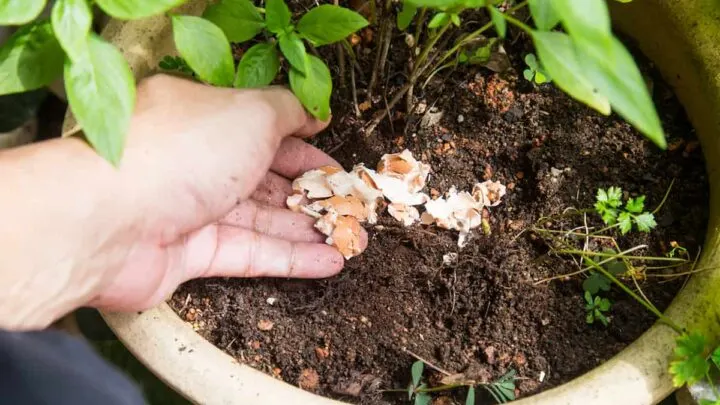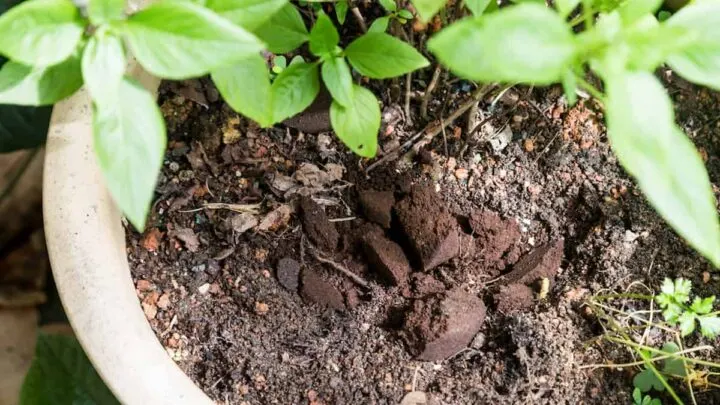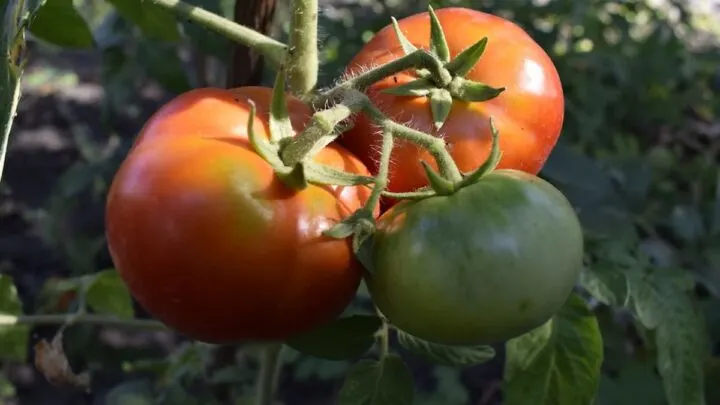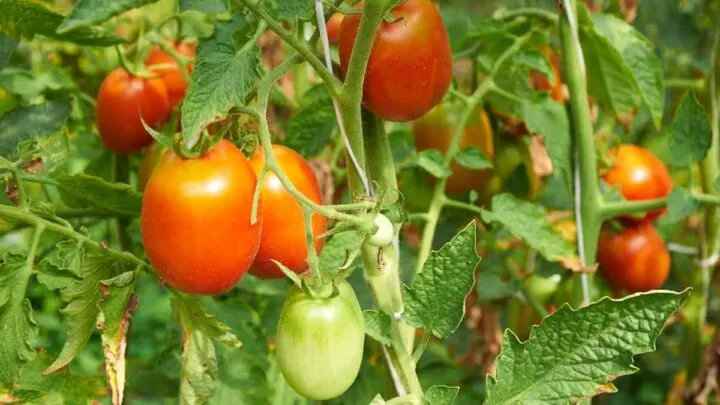Tomato plants are a staple in gardens all around. Growing them is fairly easy; especially if they have all the right nutrients. Having enough calcium seems to correlate directly with healthy tomato plants that produce big, vibrant fruits.
Calcium is not only important to the plant’s growth and fruit production, but it also helps ward off diseases and disorders; such as blossom end rot. Getting enough calcium is usually covered in balanced fertilizers, but sometimes tomato plants just don’t get enough.
To help you get the most out of our tomatoes, I researched and compiled a huge list of ways that you can add calcium to your tomato plants. This includes mostly natural sources of calcium that you can find in everyday items in the home. The list also includes a few synthetic options that are relatively safe for garden plants.
Read on to learn more about adding calcium to your tomato plants!

Various Sources Of Calcium For Tomatoes
Calcium for tomatoes can be gathered from all types of sources. Whether it be natural, synthetic, or even something homemade, it’s easy to find calcium-rich additions to your garden. Below is a helpful table showing some calcium percentages for a variety of fertilizers and natural sources.
| Calcium source by type (or brand) | Calcium by % |
|---|---|
| Epsoma Tomato-tone | 8% |
| Dr. Earth Tomato, Vegetable & Herb Fertilizer | 7.5% |
| Bone Meal | 12% |
| Calcium Spray | 1.6% |
| Wood Ash | 25% |
| Eggshells (brown or white) | 40% |
| Gyspum Powder | 29% |
| Coffee Grounds | 2% |
As you can see, there are a lot of differences in calcium content here. That’s something to keep in mind when adding them to your plants. The last thing you want to do is add too much calcium to your tomato plants. Adding too much calcium to tomato plants can harm them greatly.
In most cases, natural sources are better to use as they take time to break down in the soil. Let’s jump into those next!

Natural Sources Of Calcium For Tomato Plants
Anytime you can help your garden flourish in a natural way, that’s always a plus. This holds true for tomatoes as the more natural the ingredients, the better off the plant will typically perform.
Thankfully, calcium is relatively easy to get a hold of from a variety of natural sources. This includes things such as Eggshells and coffee grounds; something easily found in most households.
There is also Gypsum powder which, believe it or not, is a natural source of calcium. Let’s dive into each of these and explain how it works.
Eggshells
Egg shells are packed with all kinds of good things, calcium being one of them. The average amount of calcium in a large egg is roughly 380 – 400 mg. That’s roughly 40% of the entire eggshell!
So, for tomatoes, it’s a great calcium supplement. In addition to this, eggshells provide other helpful components such as magnesium and potassium; along with trace minerals. All of those are just what a tomato needs to produce healthy fruit and stay strong.
But, how exactly do you apply this to your tomatoes? should you just crush them up and dump them in the soil?
Well, in theory, you could, but that could get messy.

Instead, I highly recommend adding the eggshells to your compost bucket or pile. This will give them a chance to break down a bit into the soil, and then you can add that compost into your tomato plants’ soil. Mix it in well with a tiller, and then water them well each day so that it can start transferring to your plant.
If you want your eggshells to decompose faster, it’s advisable to grind them into a fine powder, then mix them into the soil.
Coffee Grounds
Although calcium is highly touted for its nitrogen content (something tomatoes need for beautiful green leaf development), it’s also an excellent source of calcium.
A cup of brewed coffee grounds contains just shy of 5mg of calcium.
While this may not be as much as an egg, it’s a nice way to add in calcium if you want to gradually introduce it to your plant.
The beautiful thing about coffee grounds is that they’re already ground into a fine form. So, that makes it easy to distribute it directly to your tomato soil. You can of course add it to compost, and even combine it with eggshells too.

Gypsum In Powder Form
Gypsum powder is a popular soil conditioner with the purpose to improve soil structure. In most cases, it’s water soluble, so it’s easy to add to your tomato plants. It’s a naturally occurring calcium sulfate, and the levels are usually 29% calcium and 23% sulfur.
For application, you may not need to add much. Every 100 square feet of garden space needs about 1 to 2 pounds of this powder. Spread evenly, till into the soil, and then water it generously.
If planning to add Gypsum to individual tomato plants, then you’ll want to just do a small handful around the roots.
Additional Options
Although adding calcium to your tomato plants is best done naturally, sometimes synthetic options are a better choice. They’re easily available and simple to use. Below are two you can try:
Calcium Spray
Did you know calcium spray was a thing?
Well, it certainly is and it’s a popular option for garden vegetables; especially tomatoes. For home gardeners, you can actually make this in just a few steps, and then add the solution to your plant’s root zone.
To make calcium spray, you can combine eggshells and brown rice vinegar in a jar. What the vinegar does is help the eggshells quickly release the calcium. After adding the eggshells to the vinegar, you should see the process working and it’ll start making bubbles as the eggshells break down.
Let the solution sit for a few days and it’ll be ready to go!
Before applying your calcium spray to your plants, be sure to dilute it in water (non-chlorinated). add it to a spray bottle and then apply it to the root zone. Applying it to foliage won’t necessarily work.

Fertilizers
Last but not least, an easy way to help your tomato plant get more calcium is to use fertilizer. There are many available on the market from popular brands that are high in calcium.
The fertilizers come in various forms. Some of them are in granular or powder form, and then others such as Rot Stop products come in a spray form. Fertilizers all have varying levels of Calcium percentages; some are more concentrated than others. This option is great if you want to really control how much you add to your plant.
Rot Stop is a favorite for many gardeners because it’s aimed primarily at blossom end rot. You don’t have to dilute it, and it’s ready to use out of the bottle. Unlike the other types, you can apply this directly to the stems, root area, and even on the foliage and fruit itself. The spray can be used up to the day of harvest as well.
Dr. Earth also makes great products, and I can personally vouch for their bone meal.

The Impact Of Calcium On Tomato Plants
One of the most impactful ways calcium affects tomato plants is by preventing disease. Blossom end rot is the most common one here, and adding calcium to your plant can prevent it before it starts.
Before going on this journey of adding calcium to your tomato plants’ soil, you need to determine if you really need to in the first place.
The thing with blossom end rot is it’s not always that the soil doesn’t have enough calcium, but rather the plant has some sort of inability to uptake those nutrients. If the soil is cold or waterlogged, or the drainage is poor, that can cause this too.
Also, if you overfertilize with too much nitrogen, it can also hurt your plant’s ability to take in calcium. And just to be honest, not every tomato plant is created equal. Some varieties are less susceptible to calcium problems than others.
Depending on where you live, some soils may already naturally have enough calcium in them naturally. If you’re not sure how much calcium is in your inground or container plant soil, then you could also do a soil test.
Final Thoughts
Calcium is very important for tomato plants to thrive. Generally speaking, if the levels of calcium are below 300ppm, then your soil probably needs a calcium boost.
And of course, if your soil is fine with calcium and your plant has a tough type taking it up through the roots, then investing in a calcium spray will help. Planting something that just doesn’t respond too adversely to a lack of calcium can also solve your problems.
Also, keep in mind what conditions you plant your crop in. By this, I mean inground vs in a container or pot.
When it comes to calcium deficiency in your plants, you’re likely to see more issues with the potted tomato plants. As those containers drain over time, they lose nutrients. It’s not infinite, and so it’ll likely need to be replenished periodically.

Hi there, my name is Allie and welcome to my blog; GareningWithAllie!
Much of what you see written here is just our personal experiences with gardening. Along with the content I write here, there is also a unique collection of gardening topics covered by some of our close friends. I hope you find everything you read here to be helpful, informative, and something that can make your gardening journey the most lovely experience ever! With that said, Happy Gardening!
